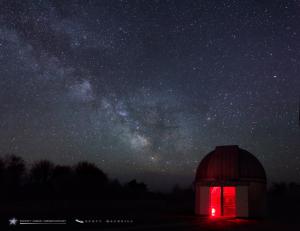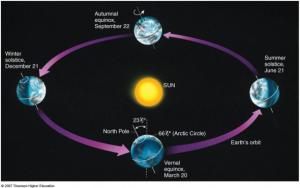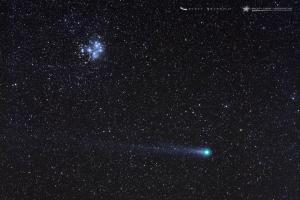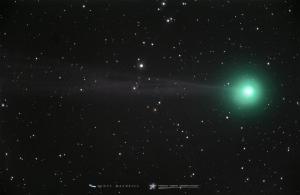
Stargazing Night
- Where:
- Frosty Drew Observatory
- When:
- Friday December 18, 2015 at 6:00 p.m.
- Cost:
- $1 Suggested Donation per Person
Tonight is Stargazing Night at Frosty Drew Observatory and the forecast is calling for clearing conditions as the night progresses. We can expect cloudy skies at the start of our evening, quickly becoming mostly cloudy with near full clearing by 9:00 p.m. We also have a likelihood for significant winds in the park tonight. This will likely restrict our viewing to only one side of the sky, depending on how acceptable wind gusts remain. Add in that the first quarter Moon will be hanging brightly over the Observatory until midnight, and we have a good probability of stargazing opportunities tonight.
We will open the Observatory and Sky Theartre at 6:00 p.m. tonight. In the Observatory we will start on standby and wait for signs of clearings. Once the sky breaks, we will direct our telescopes towards the first quarter Moon, binary stars, Uranus, and possibly Jupiter later in the night. In the Sky Theatre we will feature our popular showcase of celestial objects photographed at Frosty Drew Observatory. Temps outside will be rather cool, though the Sky Theatre will be warm and available for breaks from the chilly conditions. We will stay open until the clouds, wind, or fatigue chase us out. Check in on our Twitter (@FrostyDrewOBSY) or Facebook for updates from the Observatory. As we always post a “Closing up” message when we decide to pack it in.
Overall, tonight's conditions are not looking all that fabulous. Clearing clouds and gusty winds will make for less than optimal viewing conditions. The bright first quarter Moon and binary stars can serve as a nice bail out as long as the wind doesn't restrict our viewing. Regardless, it is still a night out under the stars and a worthy one at that with Jupiter rising at much earlier times. So take a trip out to Frosty Drew Observatory tonight and have a holiday ramp-up out under the stars.
-------------------------------------------------------------------------
Weekly Happenings
Scott MacNeill
On Monday, December 21st at 11:48 p.m. EST, the Winter Solstice will occur, marking the start of the winter season. The Winter Solstice is the point when Earth's axis is most inclined away from the Sun in the Northern Hemisphere and most inclined toward the Sun in the Southern Hemisphere. This will cause Earth's celestial equator to rise 23.4° above the Ecliptic, which is the path the Sun takes through the sky and represents the plane of the Solar System. During the Winter Solstice those residing on the Tropic of Capricorn will see the Sun at zenith (directly overhead) during midday and the Antarctic Circle will experience 24 hours of sunlight with the Sun dropping to the horizon at midnight, hailing the Midnight Sun. Consequently the Arctic Circle will see near 24 hours of darkness with the Sun just barely rising to the horizon during midday.
All that aside, the Winter Solstice brings us the long cold of winter, festive holiday lights, Smoking Bishop, much Dickens goodness, and the merriment of time spent with friends as the height of our winter celebrations and the final approach to the end of the year come together.
This month and into the winter, we have a number of comets coming into view. Though none are expected to become naked eye visible at this point, they are offering up fabulous binocular and small telescope viewing opportunities.
The first of these comets is the highly acclaimed comet C/2013 US10 Catalina. Current visible in the constellation Virgo, Catalina is a morning comet. The comet has formed a fabulous set of tails, with a beautiful ion tail stretching over a degree from the comet's nucleus. Over the next couple weeks, Catalina will move into the constellation Bootes and higher into the morning sky. Catch a view of comet Catalina easily in binoculars.
The second, and much less known, comet gracing our skies is comet C/2014 S2 PanSTARRS. Largely considered a morning comet, S2 PanSTARRS currently resides in the constellation Draco, where it will remain for the next month. This will make the comet visible all night long from New England latitudes, with best viewing times in the evening at the close of twilight and in the morning after 3:00 a.m. Though not as easily spotted in binoculars as Comet Catalina, S2 PanSTARRS can be seen in binoculars and small telescopes.
The third and last comet worth spotting this winter is comet C/2013 X1 PanSTARRS. Though not binocular visible, X1 PanSTARRS will be visible in small backyard telescopes. This comet is easily a night time comet, currently residing in the constellation Andromeda. X1 PanSTARRS will continue to descend towards the western horizon eventually passing into the constellation Pegasus just before the New Year.
Winter time has become a great time for comet spotting these past years and 2015 / 2016 will certainly continue the trend. Comets are difficult to predict and can produce outbursts at any time, flaring to significantly higher than expected visibility. Check in regularly on the Frosty Drew Observatory Facebook page for finder charts and news on how to spot these comets. Then step out and log some excellent comet hunting time this over the holiday break.
Next week, the Frosty Drew Observatory Stargazing Night will happen on Saturday, December 26th at 6:00 p.m. with the Observatory remaining closed on Friday, December 25th in observance of the winter holiday. Here's hoping you find awesome merriment and great times on your winter holiday from all of us astro-geeks at Frosty Drew. We'll see you soon!
-Scott



